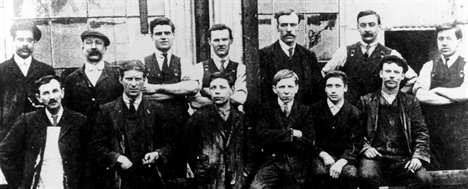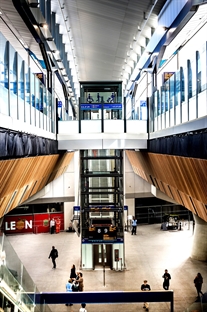07.09.17
Celebrating 150 years of engineering excellence
Source: RTM Aug/Sep 17
As Stannah celebrates a very special anniversary, Peter Perry, managing director of Stannah Lift Services, writes about the company’s history and why it is particularly proud to be increasingly associated with the rail network.
This year marks 150 years since Joseph Stannah established a lift company that remains British, independent and family-run, with a growing reputation for delivering great projects within the rail industry.
Established in 1867, the company first made its name making hoists and cranes for London’s dockyards. This was the day of the industrial revolution and Victorian engineering changed the face of Britain – and the world. These were exciting times for rail too. It was the only way to travel for passengers exploring the UK and the only overland mode of transportation for goods.
It is hard for us to imagine the speed of the development of train travel and the achievements of the engineers who conceived and built the railway network and the rolling stock.
- 1825 – The first freight rail line opened: Stockton to Darlington – built by George Stephenson
- 1833 – Passenger steam trains ran on the Stockton to Darlington line
- 1838 – Robert Stephenson (George’s son) completed the London to Liverpool line
- 1841 – Isambard Kingdom Brunel engineered the line GWML between London and Bristol
- 1850 – Steam trains converged on London with passenger alighting at a myriad of stations including Paddington, Euston, King’s Cross, Fenchurch Street, Charing Cross, Waterloo or Victoria, and then having to travel into the ever-more congested City by hackney cab
- 1858 – So many rail lines had been built that it was now possible to travel from Scotland or Wales to London in a fraction of the time travelling overland
- 1863 – Enter the Metropolitan Line, built underground to join some of the London stations – the beginnings of London Underground

Travel by train was not exclusively for the privileged. There were three grades of travel, third class being in open carriages in the early days. Just as the speed of train networks gained pace, travel by train became accessible for all.
Vertical travel for passengers became desirable too. The first passenger lift in London was installed in 1860 in the Grosvenor Hotel for the benefit of the privileged classes. Department stores vied for customers by including ‘moving rooms’ in their list of attractive interior features to help the discerning and wealthy shoppers.
The earliest Stannah ‘lifts’ were often hand-wound or steam-driven. An advertisement in the Builder clearly promotes the company’s products in 1877.
By the turn of the century, Albert Stannah (son of Joseph) was driving the business forward, investing in advertising and a growing workforce to open up new opportunities for the company. Albert built a small factory in Boreham, Essex, in 1911. We believe this was involved in the war effort in 1917-18, and beyond.
Business was interrupted by both world wars, as both Albert and his son, Leslie, completed service during those periods. During WW2, Stannah’s factory was destroyed, along with so many businesses in London at that time. With no workforce, drawings or components available to him, Lt. Commander Leslie Stannah rebuilt the business from scratch using his reputable family name. The factory was rebuilt in 1945, and with the government’s help, Leslie manufactured passenger lifts, even exporting some to Palestine and Ceylon.
In the 1960s, current joint chairmen and brothers, Brian and Alan Stannah, extended the Stannah product range with the addition of service lifts (the Stannah Microlift). On the railways, life was getting tough too. In 1963 and 1965 Dr Richard Beeching published reports on the state of Britain’s railways and recommended sweeping cuts of thousands of miles of line and more than 2,000 stations to save money and make the railways more efficient. The population, who used to habitually travel by train, was using cars as an economical alternative.
Back at Stannah, the 1970s saw turbulent political times with the three-day week and the miners’ strike. This led Brian and Alan to look for product diversification to supplement the downtime of the lift factory. The Stannah Stairlift was born.
In the latter part of the 20th century the company expanded its stairlift sales to become a global player, developed its product range and continued to be proud of its British family engineering heritage. Stannah’s UK-wide service branch network was established to provide local service for lifts from all manufacturers and in all marketplaces. Today, that network looks after more than 90,000 lift products.
The 21st century sees the company safe in the hands of five members of the next Stannah generation – passionate as ever about their forefathers’ achievements and the potential for new products and new markets.

Stannah has installed over 45,000 passenger and goods lifts, 600,000 stairlifts (worldwide) and added escalators, moving walkways and loading systems to our portfolio, including the national maintenance portfolio for Network Rail and DLR. From this has grown major infrastructure project capability – rail projects include King’s Cross station, Leeds station, Edinburgh Waverley and Edinburgh Haymarket stations, Reading station, Nottingham Hub, Birmingham New Street,
London Bridge station, Waterloo and the Poplar Link Enhancement Project, that links DLR with the Crossrail network.
A legacy
When asked what reaching this milestone means to the Stannah family, Jon Stannah, group managing director and descendant of Joseph Stannah, said: “It means a great deal. Family is all about generations, the legacy left behind and the future generations that will continue to grow the business.
“We are very lucky to know the history of our company – this celebration is not just about the Stannah family, but also about the wider family that is the Stannah corporation. We are particularly proud to be increasingly associated with our rail network that continues the engineering tradition of our nation.”
The heartbeat of the company and the main contributor to its success is the hard work and loyalty of its staff, that currently numbers almost 2,000.
The Stannah Promise
Stannah makes a promise to all its customers, suppliers and partners to be ‘always true to our word’.
For more information
W: www.stannahlifts.co.uk/150